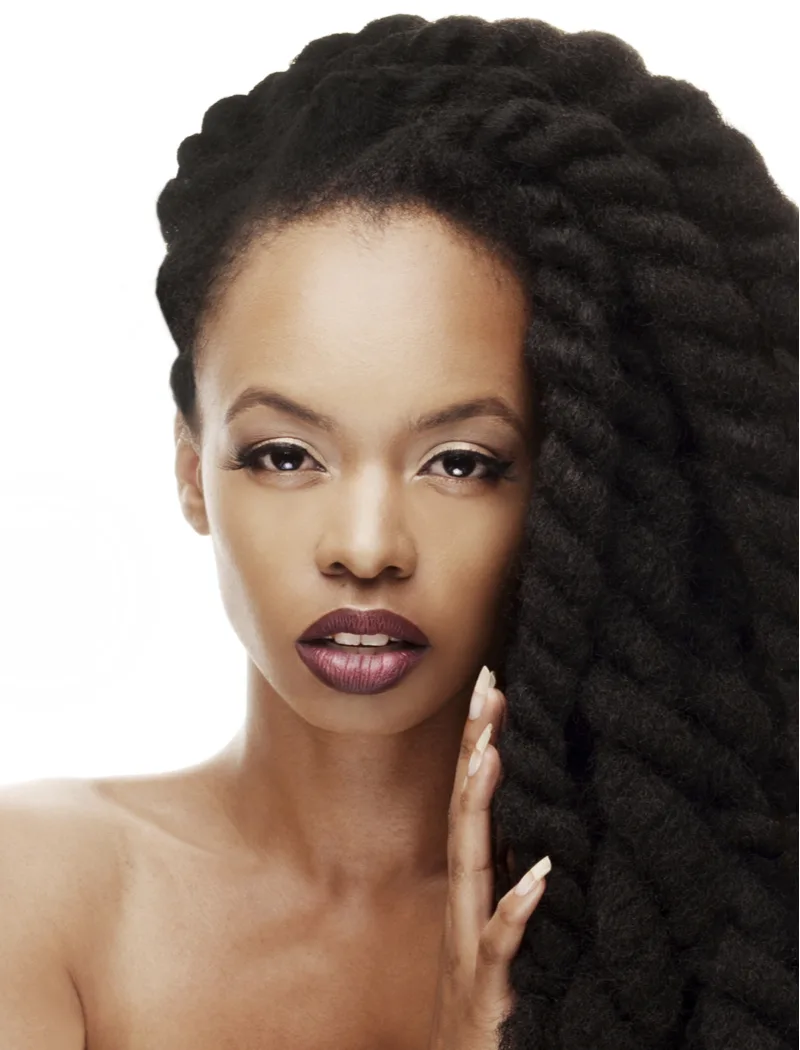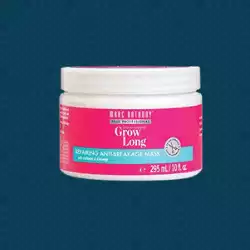Jump to:
With springy, defined coils that are less prone to shrinkage than other type 4s, the 4A hair type is known for its voluminous, prolific texture.
Strands can be fine, medium, or coarse, but this hair type has the dense, spongy feel common to all type 4 coily hair type categories. Learn how to manage and care for your 4A coils with this quick reference guide!
What Is the 4A Hair Type?

Kiuikson/Shutterstock
The 4A hair type features the biggest, most defined coils of all coily type 4s (4A, 4B, and 4C). The 4A type has tightly wound, springy coils about the size of a coffee stirrer. The 4A coils can be S-shaped (like curls) or O-shaped (like kinky coils).
The texture of 4A hair varies widely from fine all the way to coarse. Classifying this hair type really relies on the coil pattern and shape more so than the texture (fine, medium, or coarse) of your strands.
It’s easy to mix up curly type 3C and coily type 4A because both feature tight curls/coils that deal with a lot of frizz and boast tons of curl volume. However, 4A coils are tighter than 3C corkscrew curls and 3C curls are typically softer to the touch.
Here are the general characteristics of 4A hair:
- Defined S- or O-shaped tight coils the size of a coffee stirrer
- Extremely voluminous and dense
- Tends to be very dry and frizzy
- Prone to tangles and breakage
- Soaks up moisture like a sponge
- Experiences less shrinkage than 4B and 4C types
Not sure if 4A really describes your hair type? You could fall under one of the related hair types, depending on the size and circumference of your coils/curls and the overall texture.
- Type 3C: Fine-to-coarse textured, tight corkscrew curls about the size of a straw
- Type 4A: Fine-to-coarse textured, very tight S- or O-shaped coils about the size of a coffee stirrer with limited shrinkage as it dries
- Type 4B: Medium-to-coarse textured, extremely tight Z-shaped kinky coils with poor definition and notable shrinkage as it dries
Now that you’re clear on what 4A hair is (and what it’s not), let’s talk about the best and worst features of this hair type next. Then, we’ll cover the care and maintenance basics for washing, drying, and styling this hair type for the best results.
Best Features of 4A Hair
There’s so much to love about the coily 4A hair type. While these coils are the “biggest” of all type 4s, they’re still super tight in comparison with looser type 3 curls.
The tightly wound spiral or circular shape of 4A hair creates tons of flattering volume, plenty of coil definition for a polished look, and minimal shrinkage compared to other type 4s.
Prolific Coil Pattern and Volume
The 4A hair type features prolific, defined coils with a strong coil pattern (springs back when you stretch it) and lots of flattering volume. You’ll never have to worry about your mane looking limp and flat because it has natural volume built right in!
The springy coil shape means no strand lies flat, and when you combine hundreds of little coil groups stacked up throughout your mane, the result is big volume that flatters your face shape and lifts hair from root to tip.
You also get a boost in volume with your hair’s high density (strands packed closely together). You have a lot of hair, a lot of shape, and that means a lot of volume.
Most Coil Definition of All Type 4s
Type 4 coilies range from your coily type 4A all the way to the kinkiest type 4C. Out of all three type 4 categories, 4A has the most coil definition and really shows off the coil pattern and shape.
While 4B and 4C can look like a dense, spongy mat of hair with a few defined coils or kinks here and there, the 4A type typically has great coil definition and doesn’t take on the fluffy look as easily as other type 4s.
Minimal Shrinkage
Type 4A hair does deal with some shrinkage (loss of length as the hair dries into the naturally tight coil pattern), but not nearly as much as type 4B or 4C. Your hair looks longer when it’s wet or when you stretch out a coil, but you typically have minimal shrinkage.
For example, your hair may hang down to your bra strap when it’s wet and gently stretched out, but hangs near your shoulder blades when it’s dry. Compared to type 4C, which experiences the most shrinkage (up to 75%), shrinkage is thankfully not one of 4A’s main concerns.
Most Manageable Type 4 Hair Type
Type 4 coily hair is generally known for being more challenging to manage than straight, wavy, or curly hair types. But 4A is the easiest of all type 4s to manage and maintain. That’s due to a combination of factors: Your coil pattern and shape, natural coil definition, and resistance to shrinkage.
Since your coil pattern is the loosest of all type 4s, it’s easier to style and manage your individual coil groups. The tighter the coil, the more manipulation and individual attention to each coil group is needed.
With your coffee stirrer-sized coils, you don’t have to work as hard to moisturize and style your coil groups. Your naturally high coil definition is another bonus that makes managing 4A hair easier. You need less products than other type 4s to achieve ideal coil definition and a polished, perfectly styled look.
Your mane’s natural resistance to shrinkage is another thing that makes managing your hair easier. You’ll experience some shrinkage, but nothing like the shrinkage associated with kinkier 4B and 4C hair types.
Worst Features of 4A Hair
We’ve covered the best features of 4A hair, but you know it’s not all sunshine and roses. Here are some of the most common challenges women with the 4A hair type face.
Prone to Dryness and Frizz
Your hair type and coil pattern lend themselves to chronic dryness and frizz because your strand shape limits how much of your scalp’s oil (sebum) can successfully make its way down the hair shaft.
Sebum’s job is to moisturize and lubricate strands, and moisturized strands feel smooth and clump into coil groups easily without frizz.
When your hair is chronically dry because it’s not getting enough sebum along the shaft, you’ll run into lots of frizz, a rougher texture, and may experience less coil definition.
Read Next: How to Get Rid of Frizzy Hair
Always Battling Breakage
Your hair type is more fragile than straight, wavy, and curly types because there are so many bends, twists, and kinks in it. When you’re cutting through a strip of metal, you bend it first to weaken it enough so it’s easy to break.
Your hair follows this same principle, with every bend and curve acting as a weak point where breakage is common. You can shore up the strength of your hair with protein-enriched products and masks that help fortify your strands to protect against breakage.
- Sulfate-free.
- Inexpensive product.
- Hydrates, controls frizz, and nourishes hair.
- Long ingredient label with synthetic ingredients.
- Not ideal for thin hair.
We really like Marc Anthony Grow Long Hair Mask for Dry Damaged Hair because it contains hydrolyzed protein to repair and strengthen your hair along with nourishing avocado and argan oils that seal moisture in.
Protective Styles Don’t Last As Long
Protective styles are a clear choice for type 4 coily hair because they prevent damage, gently stretch the hair to combat shrinkage, and make styling much easier. But for type 4As, protective styles don’t last as long as they can with coilier type 4Bs and 4Cs.
This is due to the nature and shape of your looser coils. While 4B and 4C coils seem to interlock together, forming a mass of dense hair, 4A coils spiral away from each other and don’t naturally lock together.
This makes holding long-term protective styles difficult for the 4A hair type. Protective styles can generally be worn for up to 5 days if you have the 4A hair type.
Maintenance and Care Tips for 4A Hair
Caring for your coily 4A hair is a lot easier when you’ve got a solid plan with clear steps to take. Find out how often you should wash 4A hair, best drying methods and products to coax the best curl definition and coil pattern from your strands, and styling methods that work best for your hair type.
Washing 4A Hair
How often should you wash 4A hair? The general consensus is to shampoo coily 4A hair once a week, but your specific shampoo schedule should be based on the actual texture (not shape) of your strands.
Your strand’s texture (fine, medium, or coarse) tells you how long you can reasonably go between washes without letting your hair get extremely dirty, greasy, or odorous.
Fine 4A hair needs to be washed once every 2 days to avoid excessive oil at the roots. Because your coils require a few layered products and special curl-defining methods (scrunching, praying hands, finger coiling, etc.) to look their best, wash days can be frustrating and annoying.
For this reason, you may find that washing a little less often – once every 3 or even 4 days – is a better fit for you. Dry shampoo can help soak up any excess oil in between washes.
Medium 4A hair should be washed every 4-5 days. This wash schedule will help you ensure your hair stays clean without needlessly stripping away your natural scalp oils daily. You get the moisturizing benefits from your natural sebum and more time to enjoy your carefully styled curls in between shampoos.
Coarse 4A hair should be washed once a week or so. Coarse textured strands hold onto moisture more effectively than fine and medium textures, so you get additional moisturizing benefits when you wash less often. Coarse hair also takes longer to look greasy, so there’s no reason to wash coarse 4A hair more often than once a week.
If you haven’t found great products for your 4A coils yet, check our list of the best shampoos for curly hair. These are general guidelines that can get you on the right track.
But if you want the most personalized wash schedule for your hair, our short quiz will help you learn how often you need to wash your hair (and why): How Often Should I Wash My Hair? | Quiz Time!
Drying 4A Hair
Drying type 4A coily hair is tricky and typically involves several steps. After you’ve shampooed and conditioned your hair, you should follow these product layering steps before drying to ensure the smoothest, frizz-free coils with lots of shine and definition.
- Leave-in conditioner
- Mousse or foamy product
- Styling/curl cream
- Styling gel
- Oil
As you can see, you start with the lightest-weight products and layer on the heavier products last. Layering the proper types of products in the right order is absolutely key for 4A hair.
Start with spraying leave-in conditioner into your soaking wet hair, then use a half-dollar sized amount of mousse throughout. Follow up with your curl-enhancing cream, then styling gel, and top it all off with a sealing oil that keeps moisture in.
You can either apply these products all over with broad motions or target individual coil groups for the best definition. It takes longer to concentrate on each coil group, but the shiny, defined results make it worth it.
If you don’t have a favorite product in each of the 5 categories above, check out some of our favorites:
- Best Conditioner for All Hair Types | 7 Of Our Faves
- Best Products for Curly Hair | Our 11 Must-Haves
- The Best Hair Gel for Black Hair in 2022
- Which Oil Is Best for Hair? | Our Picks Will Shock You!
After layering your products into your soaking wet hair, you can either air dry or diffuse dry with a hair dryer. We recommend air drying for 4A hair because it won’t lead to heat damage. If you plan to diffuse dry instead, make sure you protect your strands with a good heat protectant spray first.
Styling 4A Hair
Your 4A hair has lots of styling possibilities, but you’ll likely find yourself sticking to 2-3 go-to styles that are manageable and cut down on your hands-on styling time.
Some of our favorite styles for 4A hair are wearing it down and loose (on wash day and for a day or two afterward), short-term protective styles, and high-volume ponytails.
Let Your Coils Do Their Thing

Kiuikson/Shutterstock
Let your coils hang out and come into the fullness of your natural 4A texture with down and loose styles. These are best right after wash day so your coils are layered with moisturizing and curl control products that give you perfect definition and shine. The bigger, the better!
Short-Term Protective Styles

James Mosley/Shutterstock
Short-term protective styles like Senegalese twists are ideal for 4A hair. Since your texture doesn’t tightly hold protective styles long-term, styles like twists and braids can help you protect and control your hair without keeping them in for 2+ weeks. Plus, when you take the style down, you’ll have lots of body with defined curls or waves!
High-Volume Ponytails

Dasha Petrenko/Shutterstock
High ponytails placed at the crown are a perfect style option for 4A hair. With your natural body and volume plus all that coil definition, gathering your coils up high allows them to spill over the top and sides for a gorgeous look that can be casual or chic.
Things to Consider
Your best hair days are still on the horizon! Once you put these care tips into action and start adjusting your products and hair care routines, you’ll see a big difference in how manageable, healthy, and bouncy your 4A coils are.
If you really want to make the most of your hair type, take these additional considerations to heart.
- Condition with heat for extra moisture. Heat helps your hair open up to accept moisture more readily, so if you can apply a little heat each time you add moisture, your mane will be stronger, less frizzy, and better hydrated. A heated conditioning cap is perfect for 4As!
- Sleep with a bonnet on it. Silk or satin bonnets help prevent your coils from being squished and flattened out while you sleep. Cover your hair with a bonnet at bedtime to wake up with less-frizzy, bouncier coils that can easily be reactivated with a little water and leave-in conditioner.
- Consider extensions for long-term protective styles. Your natural hair texture has a little more slip than other type 4s, so long-term protective styles simply don’t work. You can make your braids or twists last longer with feed-in extensions that hold and grip better than your strands can. Plus, you’ll have the freedom to rock longer lengths that aren’t as heavy as natural hair!
- Use coconut oil liberally. After applying your leave-in conditioner, mousse, curl cream, and gel, you should follow up with a sealing oil to lock all that product and moisture in. Coconut oil is best because it actively penetrates hair strands to leave your 4A coils moisturized and prevent the moisture from evaporating quickly.
The 4A Hair Type: A Summary
Following the care methods and tips you’ve learned in this guide and keeping these considerations in mind will transform your 4A coils. More moisture, better definition, and stronger strands that resist breakage are all in your future when you take care of your coils.
Eager to learn more about your hair type – or unsure if you’re truly a 4A? Take the quiz next to make sure you’ve typed your hair correctly: Take Our Hair Type Quiz.

